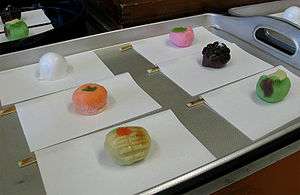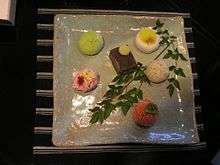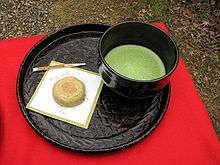Wagashi
Wagashi (和菓子, wa-gashi) are traditional Japanese confections that are often served with green tea, especially the types made of mochi, anko (azuki bean paste) and fruits. Wagashi are typically made from plant-based ingredients.[1]
 Hotaru (firefly) wagashi | |
| Type | Confectionery |
|---|---|
| Place of origin | Japan |
History

In Japan, the word for sweets, kashi (菓子), originally referred to fruits and nuts.[2] With the increasing sugar trade between China and Japan, sugar became a common household ingredient by the end of the Muromachi period.[2] Influenced by the introduction of tea, China's confectionery, and dim sum, the creation of wagashi took off during the Edo period in Japan.[2]
Types



- Akumaki: one of the confections of Kagoshima Prefecture
- Anmitsu: chilled agar jelly cubes (kanten) with fruit
- Amanattō: simmered azuki beans or other beans with sugar, and dried—amanattō and nattō are not related, although the names are similar.
- Botamochi: a sweet rice ball wrapped with anko (or an, thick azuki bean paste)
- Daifuku: general term for mochi (pounded sweet rice) stuffed with anko
- Dango: a small, sticky, sweet Japanese dumpling, commonly skewered on a stick
- Dorayaki: a round, flat sweet consisting of castella wrapped around anko
- Gokabou: a sweetened cake made of rice and mixed with sugar
- Hanabiramochi: a flat, red and white, sweet mochi wrapped around anko and a strip of candied gobo (burdock)
- Ikinari dango: a steamed bun with a chunk of sweet potato and anko in the center, it is a local confectionery in Kumamoto.
- Imagawayaki (also kaitenyaki): anko surrounded in a disc of fried dough covering
- Kompeito: crystal sugar candy
- Kusa mochi: "grass" mochi, a sweet mochi infused with Japanese mugwort (yomogi), surrounding a center of anko
- Kuzumochi
- Kuri kinton: a sweetened mixture of boiled and mashed chestnuts
- Manjū: steamed cakes of an surrounded by a flour mixture, available in many shapes such as peaches, rabbits, and matsutake (松茸) mushrooms
- Mochi: a rice cake made of glutinous rice
- Monaka: a center of anko sandwiched between two delicate and crispy sweet rice crackers
- Oshiruko (also zenzai): a hot dessert made from anko in a liquid, soup form, with small mochi floating in it
- Rakugan: a small, very solid and sweet cake which is made of rice flour and mizuame
- Sakuramochi: a rice cake filled with anko and wrapped in a pickled cherry leaf
- Taiyaki: like a kaitenyaki, a core of anko surrounded by a fried dough covering, but shaped like a fish
- Uirō: a steamed cake made of rice flour and sugar, similar to mochi
- Warabimochi: traditionally made from warabi and served with kinako and kuromitsu
- Yatsuhashi: thin sheets of gyūhi (sweetened mochi), available in different flavors, like cinnamon, and occasionally folded in a triangle around a ball of red anko
- Yōkan: one of the oldest wagashi, a solid block of anko, hardened with agar and additional sugar
- Yubeshi
Classification
Wagashi are classified according to the production method and moisture content. Moisture content is very important, since it affects shelf life.
- Namagashi (生菓子) (wet confectionery)—contains 30% or more moisture
- Jō namagashi (上生菓子) is a very soft and delicate, seasonally varying namagashi, in various, often elaborate, shapes and colors, often reflecting seasonal plants. Some stores will have many dozens over the course of a year.[3]
- Mochi mono (もち物)
- Mushi mono (蒸し物) (steamed confectionery)
- Yaki mono (焼き物) (baked confectionery)
- Hiranabe mono (平なべ物)(Flat pan baked confectionery)
- Ōbun mono (オーブン物) (oven baked confectionery)
- Nagashi mono (流し物)
- Neri mono (練り物)
- Age mono (揚げ物) (fried confectionery)
- Han namagashi (半生菓子) (half-wet confectionery)—contains 10%–30% moisture
- An mono (あん物)
- Oka mono (おか物)
- Yaki mono (焼き物) (baked confectionery)
- Hiranabe mono (平なべ物)(Flat pan baked confectionery)
- Ōbun mono (オーブン物) (oven baked confectionery)
- Nagashi mono (流し物)
- Neri mono (練り物)
- Higashi (干菓子) (dry confectionery)—contains 10% or less moisture
- Uchi mono (打ち物)
- Oshi mono (押し物)
- Kake mono (掛け物)
- Yaki mono (焼き物) (baked confectionery)
- Ame mono (あめ物) (candy confectionery)
Characteristics
Wagashi typically takes a lot of work. It is usually named after poetry, historical events, or natural scenery.
Wagashi is well known for its delicateness and variety in appearance. This can reflect the delicacy culture of Japan.
Wagashi can be used as a great gift during festivals, and can also be daily treat for visiting guests. Different places have wagashi that are unique in flavor as their local specialty. Japanese people tend to take back home wagashi after business trips or personal trips.
Japanese people believe that the artistic characteristic of wagashi represents both a sense of the season when wagashi is made and a humble culture of Japan.
See also
- Chinese desserts – Chinese confections
- Hangwa – Korean confections
- Turkish Delight – Turkish confections
- List of Japanese desserts and sweets
- List of Japanese snacks
References
- Gordenker, Alice, "So What the Heck is That?: Wagashi", Japan Times, 20 January 2011, p. 11.
- Ashkenazi, Michael (2000). The Essence of Japanese Cuisine: An Essay on Food and Culture. University of Pennsylvania Press. pp. 106–107. ISBN 9780812235661. Retrieved Jan 30, 2013.
- Japanese Confectionery Gratifies the Eyes and the Palate Aichi Voice Issue 7, 1997
- Aoki, Naomi (October 2000). 図説 和菓子の今昔 Zusetsu wagashi no konjyaku. 株式会社淡交社 Tankosha Publishing Co., Ltd. ISBN 978-4-473-01762-8.
External links

- Japan Wagashi Association (in Japanese)